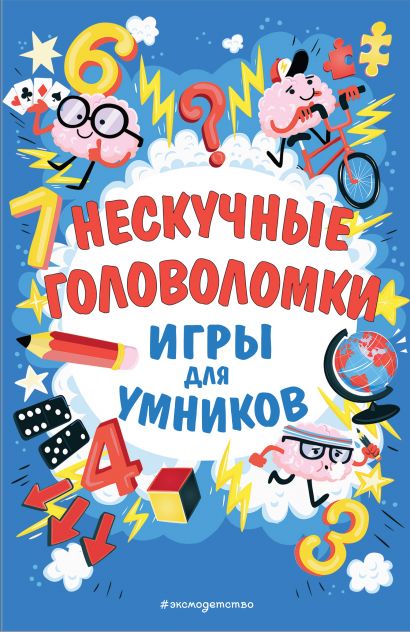Educational games for children of the sixth year of life at home in 5 years, the child goes to the category of senior preschoolers. This period marks the beginning of active training for school. Skills developed in the younger preschool age
Educational games for children 5-6 years at home
In 5 years, the child goes to the category of senior preschoolers. This period marks the beginning of active training for school. Skills developed in the younger preschool age allow the five-year-old baby to purposefully develop the skills necessary for the future first grader. At this age, the child may already assign the norms and rules of conduct, thanks to which its classes and games are more ordered, compared with the younger age, character. The child of the sixth year of life is still striving for independence, recognition from the senior comrades, parents. Adults must take into account this aspect and create prerequisites for the child's self-realization – to entrust him of the sidelines, emphasizing their importance, praise the baby, simulate situations requiring a child decisive action. But at the same time, do not forget that complex tasks can lead to the opposite result – cause difficulties and undermine the child's faith in their forces. The result of the independent actions of the baby should be a sense of pride and awareness of their own significance.
Cocking with a child preparation for school learning, develop his desire for research activities, try to introduce it to the essence of the subject, fixing attention on the details and nuances of one or another sphere. Any occupation should be clearly. If at 4 years old the result of any process does not have a decisive value for a child, then on the sixth year of life, the baby may vice versa, accelerate the process to quickly interview the fruit of his works. In this regard, one of the main skills requiring correction at this stage becomes the development of the impairment and concentration of attention. A lot of time should be given to the development of fine motility and coordination of the hands necessary to prepare a hand to a letter. Some children of this age begin to show interest in learning to read. Practice shows that these classes are fruitful, only if the baby seizes this type of knowledge on his own desire, without pressure from adults. In the other case, the result may be reverse – the child is formed a resistant rejection of everything that is associated with books, and this creates additional problems at school. Despite the sonorous term: "Preparation for school learning", parents should not forget about the young age of their wards, classes should continue to be carried out in a games form using the didactic material and any submitted means.
Games for the development of shallow motor
Handling
An occupation, developing a small motorcy in young children, can also be offered a senior preschooler. From the macaroni of a different shape, painted with their own hands and risen on the line, you can make gifts in the form of beads or bracelets for relatives and acquaintances. Small cylinders glued out of old postcards or patterns, also strung on a fishing line or a thick thread, can be a decoration, a commodity train or a beautiful colorful snake. Purify the seaw hole in the chestnuts and offer the baby to make a massage rug or frame for photos. Use for stripping berries, buttons, paper rings, cocktail straws and all that your fantasy will tell.
Cutout scissors
By teaching a child with cutting, you should develop the following skills: cutting in a straight line, the ability to cut various geometric shapes (circle, quadrilateral, triangle, etc.), the creation of symmetrical figures by cutting half the shape of the folded sheet. Suggest digging not only on the drawn lines, but also by the figurative view, for example, outline in the air any shape and ask the child to cut it out of paper. At first occupations, such geometric shapes can be cut in this way. In the future, complicate the task, describing a silhouette of a man, tree, a house. Learn the baby to plan your actions: find the most comfortable position and direction of scissors, determine the place to start the cutting process of a certain figure.
For clippings and subsequent applications, you can use old magazines, newspapers, coloring, postcards.
Coloring correctly
Drawing contours of various items, offer a child to hatch them, and do it in a certain order, for example, the roof of the house shack the lines with a slope to the right, and the house itself – the lines with a slope to the left. At the same time, pay attention to the baby on the fact that the lines should not go beyond the edges of the contours and go parallel to each other, but do not insist on it, but convince him with your own example: to announce the competition of the best hatchor and draw along with the child. Someone from family members can make an independent arbiter.
Lupek from plasticine
The exercise on the development of small motility and at the same time occupation, developing the imagination, forming a creative beginning, is a laying of plasticine or clay. At this age, the child can independently sculpt animal figures, people, folding houses from "brick" or "logs". If possible, divert jobs, create a plot base, for example, offer to blind heroes of any fairy tale ("Kolobok", "Repka", etc.), cut off the dishes for the doll, prepare a gift for some of the family members. Accompany the game with funny verses. After distributing the plasticine with a flat layer on a solid surface, it is possible to make it the basis for a mosaic, indulging in it beans, peas or cereals.
Бумажные поделки
Помогите ребенку овладеть искусством оригами. Начинайте со складывания листа в различных направлениях: вдоль, поперек, по диагонали. Чертите линии на месте предполагаемого сгиба. Когда малыш освоит это занятие, приступайте к созданию простых поделок из бумаги (пилотка, галка, кораблик). Наверняка ребенка вдохновит создание собственной флотилии или воздушной эскадры. От простых поделок можно переходить и к более сложным фигурам (животные, дома). Научите малыша плести коврики из бумажных полос, вставляющихся в прорези на бумажном листе.
A game of shadows
Перед игрой затемните комнату, источник света (настольная лампа, фонарь) должен освещать экран (светлую стенку) на расстоянии 4—5 метров. Между экраном и источником света производятся движения руками, от которых на освещенный экран падает тень. Размещение рук между стеной и источником света зависит от силы последнего, в среднем — это 1—2 метра от экрана. Актеры теневого театра могут сопровождать свои действия короткими диалогами, разыгрывать сценки. Уменьшить или увеличить размеры теневых фигур можно посредством приближения или удаления рук от экрана.
Основные теневые фигуры:
Птица, собака, лев, орел, рыба, змея, гусь, заяц, кошка.
Мой портной
Начиная с пяти лет, ребенок вполне может овладеть элементарными навыками шитья (пришивания). Подберите толстую штопальную иглу, пуговицы с большими отверстиями, запаситесь лоскутами и предложите малышу под вашим наблюдением пришить пуговицу к платью куклы или поставить заплату на старые штанишки. Покажите, как правильно держать иглу (большим, указательным и средним пальцами), объясните, для чего нужен наперсток. Кроме того, ребенку придется завязывать узелки на нитке, что тоже является эффективным упражнением для развития мелкой моторики.
Чем не Золушка?
Пожалуйтесь ребенку, что у вас произошла маленькая неприятность — перемешались два вида крупы, например, рис и гречка, а перебрать ее — времени не хватает. Попросите малыша помочь вам и разложить все по разным банкам. Чтобы ребенок не заскучал, придумайте ему сказку о том, что крупинки — это потерявшиеся человечки, которым надо помочь найти свои домики.
Игра способствует развитию мелкой моторики.
Буква растет
На чистом листе бумаги в противоположных концах нарисуйте очень маленькую и очень большую букву. Предложите ребенку изобразить процесс увеличения (или уменьшения) буквы, то есть, рядом с маленькой нарисовать букву побольше, следующая — еще больше и т.д. Обратите внимание ребенка на то, что буква должна «расти» понемногу. Таким образом, доведите букву до размеров, обозначенных на противоположном конце листа.
Игры для развития логического мышления у детей
Найди варианты
Нарисуйте 6 кругов. Попросите ребенка закрасить круги таким образом, чтобы закрашенных и не закрашенных фигур было поровну. Рассмотрите и посчитайте все возможные варианты закрашивания.Spend a competition: who will find the greatest number of solutions.

Wizards
Explain to the child the rules of the game: you draw a simple geometric shape, and on its basis creates a more complex pattern, for example, a rectangle can turn into a window, aquarium, a house; Circle – Ball, Snowman, Wheel, Apple, etc. You can conduct a game in the form of a competition: who will come up with and draws more pictures using one geometric shape. The winner is awarded a symbolic prize.
Ornament
Prepare the game material: cut out 4-5 groups of geometric figures (triangles, squares, circles, rectangles, etc.) from color cardboard. The figures of the same group are divided into subgroups that differ in color and size. Show the child, as on the playing field (a sheet of cardboard or velvet paper), you can upload ornaments from geometric shapes. Drawing an ornament on paper, suggest the baby to lay a pattern on the sample. Complicating assignment, ask the child to post an ornament under dictation, operating such concepts as "right, left, at the top, below." For example: "In the center of the sheet – a large red circle, to the right of it a small orange square, on the left – a small yellow square, over the circle – a blue triangle, under the circle – green triangle, etc.
The simplest puzzle
Cut any geometric shape on 5 or more parts. Offer the child to collect a figure. Complicating task, use the figures of different sizes, cut two identical figures with a different pattern.
To the right! Higher!
Hide the toy and offer a child to find it, listening to your tips. Touching, let's a baby search direction: straight, left, above, below: "You will find this subject if you go straight, and then turn right. The toy is below the painting, to the right of the table, etc.. In the same way, you can make the subject shown on the storyline by selecting any object as a reference point. For example: "What I fucked is below the Sun, to the right of the tree, in front of the house, etc..
Is it possible?
Draw a picture with knowingly ridiculous details, for example, dandelion among snowdrifts, apples on birch, boy with pigtails, etc. Ask the child carefully consider the image and specify what can not be. The game can be carried out in the form of a competition: who will find more "nonlapits" who will see the funniest incontamination. Change the visual material more often, pick pictures with different plots, situations. Complicating task, make mistakes, see which is possible only with attentive consideration of the picture. Suggest the baby yourself to draw a picture with "Nelpitsa".
Who needs
Imagine yourself in the form of an animated object. The child must name the conditions necessary for its livelihoods. For example, you say: "I am a flower."Научите малыша рассуждать: «Цветок растет в земле, его поливают, листья цветка дышат, в холод цветы вянут, когда светит солнце — цветок растет. Значит цветку необходимы земля, вода, воздух, тепло, свет». Усложняя задачу, можно построить игру наоборот: «Мне необходимы воздух, вода, трава или сено для питания, луг, чтобы пастись, хлев, чтобы там жить. Who am I? (cow)".
Question answer
Расставьте в ряд игрушки или любые другие безопасные предметы. Предложите ребенку найти загаданный вами предмет, задавая вопросы относительно его месторасположения. For example:
— Этот предмет справа от машины (центральный объект)?
— Предмет находится между куклой и зайцем?
Что я загадала?
Разложите перед ребенком 10 кругов разного цвета и размера. Предложите малышу отгадать, какой из них вы загадали. Объясните правила: отгадывая, можно задавать вопросы только со словами «больше—меньше». For example:
— Этот круг больше красного?
— Он больше синего?
— Это зеленый круг?
Полезно – вредно
Рассмотрите какой-либо объект или явление, отмечая его положительные и отрицательные стороны. Например: «Если идет дождь — это хорошо, потому что растения пьют воду и лучше растут. Но если дождь идет слишком долго — это плохо, потому что корни растений могут сгнить от избытка воды».
Юный архитектор
Расскажите ребенку о том, чем занимается архитектор. Рассмотрите фотографии архитектурных построек, объясните, что ни одно здание нельзя построить без предварительного плана, чертежа. Предложите поиграть в архитекторов: построить дом из кубиков или конструктора по чертежу. На первых занятиях рассматривайте простые конструкции из 4—5 деталей. Попросите ребенка построить дом и сделать чертеж готового строения. Затем возьмите на себя роль строителя, в то время, как малыш станет архитектором, то есть, сделает чертеж. Усложняя игру, можно построить несколько объектов и схематично изобразить один из них, предложив ребенку найти строение, сверяясь с чертежом.
Посади цветы
Для игры вам потребуется 40 карточек с изображениями цветов — с разной формой лепестков, разного размера, с сердцевиной разного цвета. Предложите ребенку рассадить цветы на клумбах: на круглую клумбу — все цветы с круглыми лепестками, на квадратную
цветы с желтой сердцевиной, на прямоугольную – все большие цветы. Какие цветы остались без клумбы, какие могут расти на двух или на трех клумбах?
А я думаю так!
Предложите ребенку поочередно составлять группы предметов по тому или иному признаку. Второй игрок должен убрать один из предметов группы и обосновать свой выбор, то есть, объяснить, почему он считает, что этот предмет лишний. Например, вы собрали группу из трех мягких игрушек — зайка, мишка и кот. Вы объясняете свой выбор тем, что все это — мягкие игрушки-животные. Ребенок убирает кота, объясняя, что заяц и медведь — это дикие животные, а кот — домашний.Or, the child combines the ball, a car and a cylinder into the group, explaining that it is possible to ride items. You remove the ball. Explanations: the cylinder and the car in the inverted state is not rolling, and the ball is rolling in any position. "
Games for studying the seasons for children
Pick pictures
For the game you will need didactic material: reproductions with images of seasons for seasons, for example, early autumn, late autumn, beginning of winter, mid-winter, end of winter, etc. In addition, pick up 5-7 small pictures to each topic. They can be depicted phenomena or objects characteristic of a certain time of the year, for example, snowflake, lilac branch, yellow wood sheet, chicks in the nest. Offer the child to each reproduction to find the appropriate pictures. Sets of cards must constantly change. The required material can be found in magazines, newspapers, old coloring, print on the printer.










